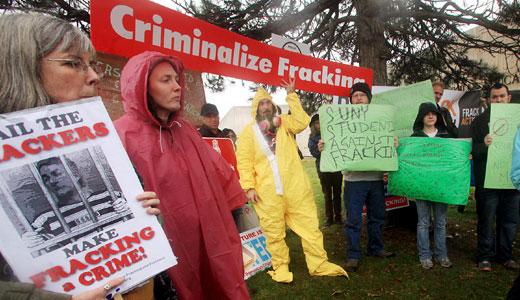
On Dec. 8, for the first time, federal environmental experts linked underground water pollution with fracking, reports ProPublica. The gas drilling method – also known as hydraulic fracturing – caused contaminants found in central Wyoming. And now, said the New York Times, fracking may have been linked to earthquakes as well.
The EPA’s discovery of the fracking/tainted water correlation was part of a larger national study it conducted to determine whether fracking posed a risk to water resources. It concluded, in a 121-page draft report, that the infected waters of Pavillion, Wyo., had more than likely arisen from gas wells and contained several compounds used in fracking fluids.
This may be a potential turning point, said the report, in the way the country views and regulates fracking – including in the coveted Marcellus Shale in New York, where, incidentally, bog turtles are severely at risk due to fracking’s effects.
Bog turtles depend on creeks and groundwater – and those resources can experience irreversible damage due to fracking. Gov. Cuomo and the Department of Environmental Conservation need to be warned of the risks, and to reconsider their fracking proposals. That is the viewpoint of the National Wildlife Federation, which is calling for people to take action – to sign their petition and make their voices heard.
If the potential damage off tampering with the Marcellus Shale isn’t warning enough of the dangers of hydraulic fracturing, then one can always look to Youngstown, Ohio for further proof.
This Ohio city, said the Times, has been seismically inactive since the Scots-Irish settlers arrived in the 18th century – that is, until Mar. 17 of this year.
Two small quakes shook the city, rattling peoples’ nerves in the process. Seven more quakes hit in the eight months that followed – an unusual occurrence, to say the least.
Though they were all too weak to really cause damage, they did manage to “scare the stuffing out of me,” said Steve Moritz. A cook on the west side of the city, he added, “It felt like someone was kicking in the front door.”
When they plotted the quake’s epicenters, Ohio seismologists found that the tremors coincided with a 9,000-foot well in an industrial lot along the Mahoney River. The well has been a disposal site for a company – D&L Energy – discarding millions of gallons of waste from fracking.
The location and timing of the quakes in relation to the waste dumping in this well pretty much says it all.
D&L officials deny any link between the disposal well and the earthquakes.
Tom Tugend, deputy chief of the Ohio Department of Natural Resources’s gas and oil division, said, “Right now, we can’t definitively say yes or no.”
Regardless, the state has asked D&L to plug the bottom 250 feet of the well with cement, as a precaution to ensure that it’s sealed from the deeper rock where the quakes are believed to have occurred.
This evidence, combined with the important new findings that offer solid scientific proof of the threat posed to water by fracking, show that the longstanding arguments by the drilling industry on why fracking is safe are simply unfounded.
In the midst of the U.S. boom in the production of gas via fracking, environmentalists and progressive activists everywhere are experiencing a strong sense of vindication as, at last, the truth about this process’s potential effects is coming to the forefront.
“No one can accurately say that there is no risk where fracking is concerned,” said Amy Mall – a senior policy analyst at the National Resources Defense Council. “This draft report makes [it] obvious that there are many factors at play, any one of which can go wrong. Much stronger rules are needed to reduce threats to drinking water.”
Photo: An anti-fracking protest takes place in Afton, New York (Michele Haskell/ Times Herald-Record/AP)












Comments